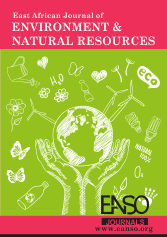Impact of Forest Landscape Restoration on Socio-Economic and Environmental Benefits in Rwanda, a Case Study of Fumbwe Sector in Rwamagana District
Abstract
The study assessed the impact of forest landscape restoration on socio-economic and environmental benefits in Rwanda, focusing on the Fumbwe Sector in Rwamagana District. It aimed to evaluate the current status of forest restoration, its benefits to the community, and the relationship between forest restoration and socio-economic and environmental outcomes. Using a descriptive and correlational design with questionnaires for data collection, the findings indicated that tree species are chosen based on soil type and altitude, with a high mean score of 3.49, suggesting good community practices. Overall, forest restoration in Fumbwe is well-managed, reflected by an average mean of 3.90. Regarding socio-economic and environmental benefits, restoration efforts were found to significantly combat erosion and protect soil, with a high average mean of 3.55. The results also revealed a strong positive correlation (0.713) between forest restoration and its socio-economic and environmental impacts, indicating substantial benefits to the community. The study concluded that forest landscape restoration contributes meaningfully to rural livelihoods and environmental protection. It recommended enhancing community involvement, planting diverse tree species suitable to the local environment, and enforcing regulations to prevent illegal forest harvesting
Downloads
References
Aerts, R. &. (2011). Forest restoration, biodiversity and ecosystem functioning. BMC ecology, 11, 1-10.
Azizi-Khalkheili, T., Aenis, T., Menatizadeh, M., & Zamani, G. (2020). Farmers’ Decision-Making Process under Climate Change: Developing a Conceptual Framework. International Journal of Agricultural Management and Development.
Clay, N. (2019). Fixing the ecosystem: Conservation, crisis and capital in Rwanda's Gishwati Forest. Environment and Planning E: Nature and Space, 2(1), 23-46.
Endamana, D. A. (2016). Contribution of non-timber forest products to cash and non-cash income of remote forest communities in Central Africa. International Forestry Review, 18(3), 280-295.
Fu, Y. L. (2013). Assessment impacts of weather and land use/land cover (LULC) change on urban vegetation net primary productivity (NPP): A case study in Guangzhou, China. Remote Sensing, 5(8), 4125-4144.
Gay, L. R., & Diehl, P. L. (2012). Research Methods for Business and Management. New York: Macmillan Publishing Company.
Kakooza, T. (2013). An Introduction to Research Methodology. Kampala: National Adult Education Association.
Khatibi, F. S., Dedekorkut-Howes, A., Howes, M., & Torabi, E. (2021, March). Can public awareness, knowledge and engagement improve climate change adaptation policies? Springer Nature.
Komba, C., & Muchapondwa, E. (2018). Adaptation to climate change by smallholder farmers in Tanzania. Agricultural Adaptation to Climate Change in Africa, 129-168.
Li, C. Y. (2021). How will Rwandan land use/land cover change under high population pressure and changing climate? Applied sciences, 11(12), 5376.
Maes, W. H. (2012). Increasing the sustainability of household cooking in developing countries: policy implications. Renewable and Sustainable Energy Reviews, 16(6), 4204-4221.
Mersha, A. A., & Laerhoven, F. V. (2016). A gender approach to understanding the differentiated impact of barriers to adaptation: responses to climate change in rural Ethiopia. Springer Nature, 1701–1713.
Mind’je, R. L. (2020). Landslide susceptibility and influencing factors analysis in Rwanda. Environment, Development and Sustainability, 22, 7985-8012.
Nair, C. T. (2013). August). African forests and forestry: An overview. African Forest Forum (AFF), 45,78.
Ndiritu, S. W., Berresaw, M. K., & Shiferaw, B. (2014, December). Are there systematic gender differences in the adoption of sustainable agricultural intensification practices? Evidence from Kenya. Researchgate, 117– 127. doi:http://dx.doi.org/10.1016/j.foodpol.2014.06.010
Ntabakirabose. (2023). Ntabakirabose, G., Mukanoheri, C., Nshimiyimana, S., Ndaruhutse, F., Tuyisenge, J. C., & Protais Musoni, D. M. M. Research Article The Impact of Forest Products Demand on Deforestation in Rwanda: . A Case Study of Burera, Gakenke, Gicumbi, Musanze, and Rulindo.
Orodho, A. J., & Kombo, D. K. (2012). Research Methods. Nairobi: Kenyatta University, Institute of Open Learning.
Orser, B., & Riding, A. (2018, January). The influence of gender on the adoption of technology among SMEs. International Journal of Entrepreneurship and Small Business. doi:http://dx.doi.org/10.1504/IJESB.2018.10011218
Sayer, J. C. (2004). The restoration of forest biodiversity and ecological values. Forest ecology and management, 201(1), 3-11.
Copyright (c) 2025 Faustin Kubwimana, Pancras Ndokoye, PhD

This work is licensed under a Creative Commons Attribution 4.0 International License.




























